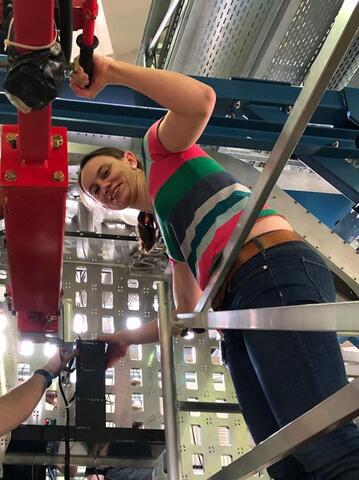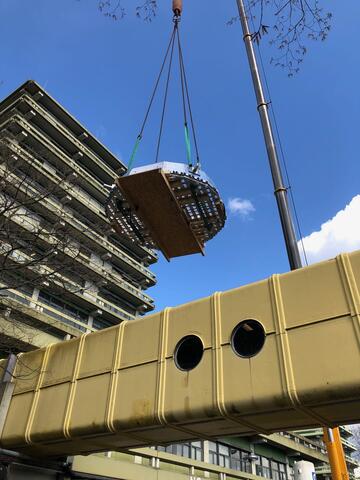Workshop „Physics Opportunities with Proton Beams at SIS100” was held in Wuppertal
PANDA meetings
04/03-08/03 2024 CM 24/1 in Münster
24/06-28/06 2024 CM 24/2 at GSI
25/06-26/06 2024 FEE/DAQ Workshop
04/11-06/11 2024 CM 24/3 at GSI
05/03-07/03 2025 WS at GSI
16/06-20/06 2025 CM 25 in Uppsala
Partial Wave Analysis of the Decay J/ψ → γωω at BESIII and Developments for the Electromagnetic Calorimeter of the PANDA Detector
Malte Albrecht
TH-PHD-2016-002.pdf
(6.59 MB)
The present thesis comprises two parts, the first of which deals with the analysis of data
recorded by the BESIII experiment at the symmetric electron-positron collider BEPCII
located in Beijing, China.
A data set of 1.31 · 10^9 recorded J/ψ events has been analyzed to study the radiative decay
J/ψ → γωω. Both ω mesons were reconstructed via their decay into π^+ π^− π^0 . A clean
sample of 75245 ± 274 events was retained after the application of an event-based back-
ground subtraction method. Prominent enhancements located at the ωω mass threshold
and at the mass of the η_c (1S) are observed in the invariant mass spectrum of the ωω
system; no resonant structures are observed in the γω system. The selected data set was
subjected to a full partial wave analysis, for which two strategies were employed: A model
independent partial wave analysis in slices of the invariant ωω mass revealed that the ωω
system is dominated by pseudoscalar (0^−+ ) contributions. This assignment also holds
for both enhancements discussed above. Additionally, significant scalar (0^++ ) and tensor
(2^++ ) contributions in the region below 2.3 GeV/c^2 were found. Based on these results,
three main contributions were considered in a model dependent analysis, where the K-
matrix formalism was employed for the description of the decay dynamics. As the result
of an iterative approach, a good description of the data was achieved using parameteriza-
tions containing five poles for the pseudoscalar (η(1760), X(1835), η(2225), X(2500), η c ),
and two poles for each of the scalar (f_0 (1710), f_0 (2020)) and tensor (f_2 (1640), f_2 (1950))
contributions, respectively. The branching fraction for the decay J/ψ → γωω was deter-
mined to be B(J/ψ → γωω) = (2.50 ± 0.01 stat ± 0.16 syst ) · 10^−3 . In a dedicated analysis
step, the branching fraction of the decay η_c → ωω was measured for the first time as a
part of this thesis and amounts to B(η_c → ωω) = (1.88±0.09 stat. ±0.17 syst. ±0.44 ext. )·10^−3 .
In the second part, studies to facilitate the construction of the electromagnetic calorimeter
of the PANDA detector at the antiproton storage ring HESR are presented. The PANDA
experiment is to be built as a part of the future FAIR facility near Darmstadt, Germany.
The production of close-to-final sub-modules for the forward endcap of the calorimeter
is presented and the assembly of photodetector-preamplifier units is discussed. These
units are equipped with a Vacuum Photo Tetrode or two Avalanche Photo Diodes, each,
to detect scintillation light from lead tungstate crystals. The calorimeter modules were
tested during various test beam times with a prototype setup, utilizing electron and tagged
photon beams in the energy range between 23 and 15000 MeV. The energy resolution of
symmetric crystal matrices was determined to be σ_E/E = (2.41±0.02)%⊕ (0.86 ± 0.02)% / sqrt(E[GeV ])
the analysis of the test beam data.
recorded by the BESIII experiment at the symmetric electron-positron collider BEPCII
located in Beijing, China.
A data set of 1.31 · 10^9 recorded J/ψ events has been analyzed to study the radiative decay
J/ψ → γωω. Both ω mesons were reconstructed via their decay into π^+ π^− π^0 . A clean
sample of 75245 ± 274 events was retained after the application of an event-based back-
ground subtraction method. Prominent enhancements located at the ωω mass threshold
and at the mass of the η_c (1S) are observed in the invariant mass spectrum of the ωω
system; no resonant structures are observed in the γω system. The selected data set was
subjected to a full partial wave analysis, for which two strategies were employed: A model
independent partial wave analysis in slices of the invariant ωω mass revealed that the ωω
system is dominated by pseudoscalar (0^−+ ) contributions. This assignment also holds
for both enhancements discussed above. Additionally, significant scalar (0^++ ) and tensor
(2^++ ) contributions in the region below 2.3 GeV/c^2 were found. Based on these results,
three main contributions were considered in a model dependent analysis, where the K-
matrix formalism was employed for the description of the decay dynamics. As the result
of an iterative approach, a good description of the data was achieved using parameteriza-
tions containing five poles for the pseudoscalar (η(1760), X(1835), η(2225), X(2500), η c ),
and two poles for each of the scalar (f_0 (1710), f_0 (2020)) and tensor (f_2 (1640), f_2 (1950))
contributions, respectively. The branching fraction for the decay J/ψ → γωω was deter-
mined to be B(J/ψ → γωω) = (2.50 ± 0.01 stat ± 0.16 syst ) · 10^−3 . In a dedicated analysis
step, the branching fraction of the decay η_c → ωω was measured for the first time as a
part of this thesis and amounts to B(η_c → ωω) = (1.88±0.09 stat. ±0.17 syst. ±0.44 ext. )·10^−3 .
In the second part, studies to facilitate the construction of the electromagnetic calorimeter
of the PANDA detector at the antiproton storage ring HESR are presented. The PANDA
experiment is to be built as a part of the future FAIR facility near Darmstadt, Germany.
The production of close-to-final sub-modules for the forward endcap of the calorimeter
is presented and the assembly of photodetector-preamplifier units is discussed. These
units are equipped with a Vacuum Photo Tetrode or two Avalanche Photo Diodes, each,
to detect scintillation light from lead tungstate crystals. The calorimeter modules were
tested during various test beam times with a prototype setup, utilizing electron and tagged
photon beams in the energy range between 23 and 15000 MeV. The energy resolution of
symmetric crystal matrices was determined to be σ_E/E = (2.41±0.02)%⊕ (0.86 ± 0.02)% / sqrt(E[GeV ])
the analysis of the test beam data.





